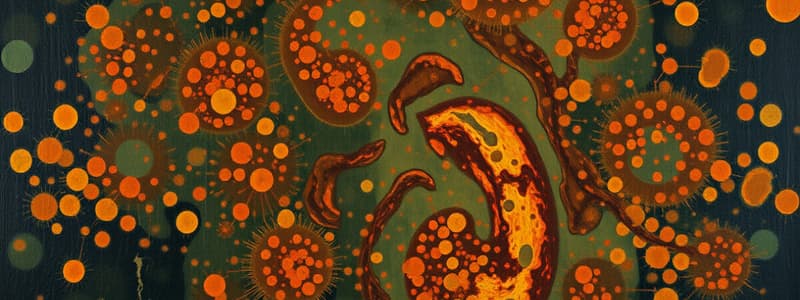Podcast
Questions and Answers
Define microbial antagonism aka competitive exclusion.
Define microbial antagonism aka competitive exclusion.
The normal microbiota can benefit the host by preventing the overgrowth of harmful microorganisms. It involves competition among microbes.
How does microbial antagonism aka competitive exclusion work?
How does microbial antagonism aka competitive exclusion work?
Microbial antagonism involves normal microbiota protecting the host against colonization by potentially pathogenic microbes by competing for nutrients, producing substances harmful to invading microbes, and affecting conditions such as pH and available oxygen.
What happens when the balance between normal microbiota and pathogenic microbes is upset?
What happens when the balance between normal microbiota and pathogenic microbes is upset?
Disease can result.
Give an example of how normal microbial antagonism occurs in women.
Give an example of how normal microbial antagonism occurs in women.
What condition can form if the pH of a vagina is off balance?
What condition can form if the pH of a vagina is off balance?
What is an example of microbial antagonism if it occurs in the stomach?
What is an example of microbial antagonism if it occurs in the stomach?
How many different microbial antagonisms can occur in the large intestines, and which bacterium are they?
How many different microbial antagonisms can occur in the large intestines, and which bacterium are they?
Define symbiosis.
Define symbiosis.
Define commensalism.
Define commensalism.
Many of the organisms that make up normal microbiota are ______.
Many of the organisms that make up normal microbiota are ______.
What are some commensals?
What are some commensals?
What are different types of symbiosis?
What are different types of symbiosis?
What is commensalism, and what is an example of the bacteria?
What is commensalism, and what is an example of the bacteria?
What is mutualism, and describe the bacteria and its environment.
What is mutualism, and describe the bacteria and its environment.
What is parasitism, and describe the bacteria and color?
What is parasitism, and describe the bacteria and color?
What is an example of mutualism?
What is an example of mutualism?
Many disease-causing bacteria are what?
Many disease-causing bacteria are what?
What are the principal components of urinary and reproductive systems?
What are the principal components of urinary and reproductive systems?
Explain different components in detail of the urinary and reproductive systems.
Explain different components in detail of the urinary and reproductive systems.
What are the principal components of large intestines?
What are the principal components of large intestines?
Explain different components in detail of the large intestines.
Explain different components in detail of the large intestines.
What are principal components of the mouth?
What are principal components of the mouth?
What are some components of normal microbiota by body region in the mouth?
What are some components of normal microbiota by body region in the mouth?
What are some principal components of the nose and throat (upper respiratory system)?
What are some principal components of the nose and throat (upper respiratory system)?
What are some components in description of normal microbiota by body region of the nose and throat (upper respiratory system)?
What are some components in description of normal microbiota by body region of the nose and throat (upper respiratory system)?
What are some principal components of the skin?
What are some principal components of the skin?
What are some components of normal microbiota by body region in details about the skin?
What are some components of normal microbiota by body region in details about the skin?
Flashcards are hidden until you start studying
Study Notes
Microbial Antagonism
- Defined as the prevention of harmful microorganisms' overgrowth by normal microbiota through competitive exclusion.
- Functions by competing for nutrients, producing harmful substances, and altering conditions like pH and oxygen levels.
Impacts of Imbalance
- Disruption of the balance between normal microbiota and pathogenic microbes can lead to disease.
Examples in Women
- The vaginal normal microbiota maintain a pH of around 4, inhibiting yeast overgrowth.
- Disruption from antibiotics or other interventions can raise pH, allowing yeast to flourish, resulting in vaginitis.
Examples in the Gut
- In the large intestine, bacteriocins are produced, inhibiting pathogenic bacteria such as Salmonella and Shigella.
- E. coli and Clostridium difficile are notable microbes involved in microbial antagonism in the intestines.
Symbiosis Types
- Symbiosis includes three types:
- Commensalism: One organism benefits, the other is unaffected.
- Mutualism: Both organisms benefit.
- Parasitism: One organism benefits at the expense of the other.
Commensals
- Organisms like Staphylococcus epidermidis on the skin exemplify commensals, providing no apparent benefit or harm to the host.
Mutualistic Examples
- E. coli in the large intestine synthesizes vitamins (K and some B vitamins) utilized by the host, benefiting both organisms.
Parasitic Examples
- H1N1 virus infects host cells, exemplifying parasitism, where the virus benefits while the host suffers.
Urinary and Reproductive Systems
- Principal components: Staphylococcus, Micrococcus, Enterococcus, Lactobacillus, Bacteroides, and fungi like Candida.
- Mucus and periodic sloughing prevent microbial attachment; urine flow and vaginal acidity help control microbial populations.
Large Intestine Composition
- Dominated by E. coli, Bacteroides, Lactobacillus, and others, representing the highest number of resident microbiota due to nutrient availability.
- Mucosal antimicrobials and periodic shedding prevent excessive microbial colonization.
Oral Microbiota
- Contains diverse microorganisms like Streptococcus and Lactobacillus.
- The presence of moisture and food promotes large microbial populations; saliva helps control microbial growth.
Upper Respiratory System Microbiota
- Components include Staphylococcus aureus and respiratory diphtheroids, with some normal microbiota being potential pathogens.
- Nasal secretions and ciliary action aid in microbial elimination.
Skin Microbiota
- Important microorganisms: Propionibacterium, Staphylococcus, and Malassezia.
- Skin secretions are antimicrobial, and the keratin barrier, along with low moisture, reduces microbial colonization.
Overall Context
- Understanding the interplay between the host and its microbiota is crucial in maintaining health and preventing diseases.
Studying That Suits You
Use AI to generate personalized quizzes and flashcards to suit your learning preferences.




